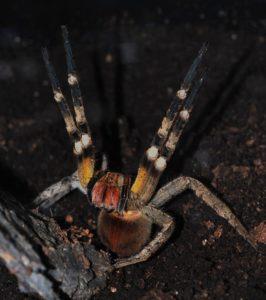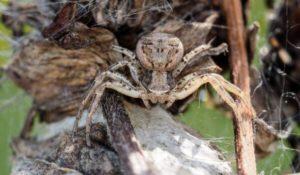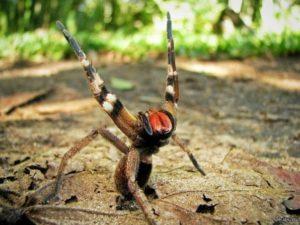Wandering Spider Soldier: A brave killer with fluffy paws
Most representatives of the arachnid class equip themselves with a reliable home in which you can hide from prying eyes or hide from enemies. At the same time, some species use their cobwebs as a refuge, while others dig deep holes in the ground. But, there are also spiders that do not need shelter and spend their whole lives traveling. These include the incredibly dangerous Brazilian wandering spiders.
Content
What Brazilian wandering spiders look like: photo
Name: wandering spider
Latin: phoneutriaClass: Arachnida - Arachnida
Squad: Spiders - Araneae
Family: Ctenides - Ctenidae
 | Habitats: | North and South America |
 | Dangerous for: | excellent night predator |
 | Attitude towards people: | bite, attack quickly |
What does the Brazilian wandering spider look like?
Brazilian wandering spiders are a genus of arachnids that hold the record and in 2010 were officially awarded the title of the most dangerous spiders on the planet. The genus of Brazilian spiders includes only 8 species.
The body length of different types of wandering spiders varies from 5 to 10 cm, and the paw span is on average about 15 cm. The color of these killer arthropods is dominated by shades of gray and brown. On the abdomen and paws there may be a blurry pattern of white or black.
The body and legs of spiders are massive and covered with many short velvety hairs. In some species, the hairline of the chelicera is significantly different in color from the rest of the body and has a reddish tint.
Breeding features of Brazilian wandering spiders
With the onset of the mating season, male Brazilian wandering spiders become especially aggressive towards each other and therefore often engage in fights with potential competitors. Also at this time, the largest number of local residents bitten by these spiders is recorded, since in search of a female, males can go far beyond their usual habitats.
Each female Brazilian wandering spider, after mating, prepares and fills 4 special bags with eggs. The total number of young individuals hatched from egg bags can reach up to 3 thousand.
Way of life of wandering spiders
Brazilian wandering spiders are nomadic and never stay in one place. This increases the risk of encountering dangerous arthropods, as they often hide in cars, houses, clothes and shoes of local residents in search of shelter during the daytime.
Spider soldier
The Brazilian spider also has another, less well-known name - the wandering soldier spider. This species got its name due to its courage and aggressiveness. In case of danger, representatives of this species never flee.
Even if the enemy is dozens of times larger than the spider itself, the brave "soldier" will remain in front of him and take up a fighting position. In this position, the spider stands on its hind legs, and raises its upper limbs high up and begins to sway from side to side.
This genus of spiders does not weave trapping webs from the web, but uses it to weave egg bags, bind the caught victim and more conveniently move through the trees.
Spider diet
Spiders of this genus are brilliant nocturnal hunters. Their menu most often consists of:
- crickets;
- mice;
- lizards;
- frogs;
- large insects;
- other arachnids.
Natural enemies
The most important enemy of spiders of this species is the tarantula hawk wasp. The insect paralyzes a Brazilian wandering spider with venom, lays its eggs inside its abdomen, and drags it into its burrow. As a result, the victim of the tarantula hawk is eaten from the inside by hatched wasp larvae.
In addition to the dangerous wasp, the following can pose a threat to the life of wandering spiders:
- rodents;
- amphibians;
- reptiles;
- predator birds.
How dangerous is the Brazilian wandering spider?
Representatives of this genus are particularly aggressive and almost never run away from danger. When meeting with a potential enemy, wandering spiders take a defensive position, standing on their hind legs and raising their front legs high.
Due to the aggressiveness of these spiders, encounters with them are very dangerous.
Upon noticing a human approaching, the Brazilian wandering spider will most likely try to attack and bite him. The poison of these arthropods is very toxic and its entry into the body can lead to the following consequences:
- sharp pain;
- respiratory paralysis;
- vomiting;
- tachycardia;
- hallucinations;
- numbness of limbs;
- convulsive muscle contraction;
- dizziness;
- a sharp increase in blood pressure.
For allergy sufferers, young children, and people with weakened immune systems, the bite of a Brazilian wandering spider can be fatal.
Brazilian wandering spider habitat
The habitat of representatives of this genus is concentrated in the tropical forests of South and Central America. The list of countries where you can meet a dangerous spider includes:
- Costa Rica;
- Argentina;
- Colombia;
- Venezuela;
- Ecuador;
- Bolivia;
- Brasilia;
- Paraguay;
- Panama.
Conclusion
Despite the small habitat, the Brazilian wandering spiders inspire fear in the inhabitants of other continents. Famous for their dangerous venom, banana spiders are representatives of this genus and very often they travel the world, hiding in large bunches of bananas.
The next



